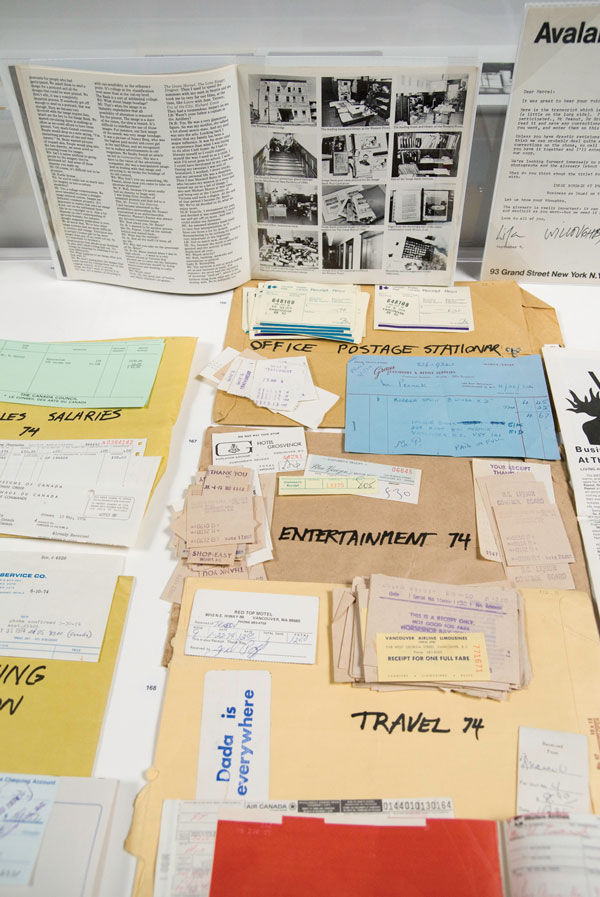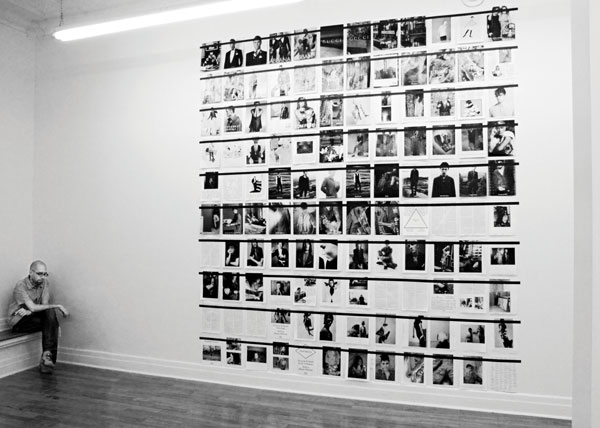[Winter 2011]
by Anne Bénichou
Anne Bénichou: Protocoles documentaires (1967–1975), a series of two exhibitions and one publication, is one of the first research and curatorial projects that you produced. In it, you explore a unique time in the history of art institutions in Canada: the development, in the late 1960s and early 1970s, of a self-managed art system from which artist-run centres emerged. Why does it seem important to look at this phenomenon today?
Vincent Bonin: Although my project mapped a local (Canadian) manifestation of the self-management paradigm, I was interested in this “historical parenthesis” mainly because it was when the transition from the capitalist economy toward the tertiary sector converged with a redefinition of the status of artists. In fact, Protocoles documentaires was first built around methodological questions pertaining to a division between the visibility and the invisibility of certain voices (and, by extension, certain texts). How can artists’ actions be narrated and interpreted when the artists identify themselves with the figure of the worker, while choosing to abandon the production of objects in favour of the conceptual offerings that, in turn, imitate bureaucratic transactions? A number of artists pursued their practices while managing these centres, while others had to momentarily (and often definitively) abandon their creative activities in order to consolidate these institutions. The consequences of this division of discourses directly affect how history is written, since they drive certain actors into anonymity while granting others the privilege of having a signature.
So it wasn’t a question only of bringing to light the history of the first artist-run centres, but also of shaping critical apparatuses that retrospectively confer intelligibility on these information-management systems and on the premature cutting out of “immaterial” work. The archives of these centres and collectives bring together all of these registers of traces.
Although Protocoles documentaires takes into account the postal system and the rise of video as a sort of conjunctive tissue of a pan-Canadian network that enabled artists to collaborate without meeting physically, I also looked at cultural workers’ “ordinary writings” (grant applications, correspondence with funding agencies). Unlike many of the collaborative projects crystallized in the “spin-offs” that were exhibited (or, at least, disseminated through the network), these texts were not intended to endure beyond the isolated occasion of the administrative transactions that gave rise to them. As a corollary, they have not been published. I gave them another space of expression first in the form of two exhibitions, and then through a publication reproducing a sampling of documents, accompanied by case studies resulting from a detailed analysis of these archives. At the same time, I also wanted to make visible the conservation and dissemination protocols of this heritage of the beginnings of self-management within the institutions that are now their repositories.
AB: What exhibition mechanisms did you develop to integrate these various registers, while conforming to the museological norms imposed by the institutions that are the repositories for these collections?
VB: I paired the mechanism of the reading room (in which documents were available in the form of photocopies) with a display space that then became the landing point for original artefacts, borrowed from institutions and presented behind glass. I thus highlighted several conditions for intellectual apprehension of the corpus of documents assembled in the course of my research. Booklets distributed to visitors offered a didactic guide (lists of pieces, commentary, chronological references) to these artefacts, while the photocopies could be read as raw materials or “out-takes” of the linear path of the exhibition. Production of the publication (the third part of the project) ran into a second series of constraints, since the gallery had to pay a high price to acquire reproduction rights for these documents. Protocoles documentaires thus showed how the historical accounts built around these archives from the early times of self-management are now anchored to the very museological complex that cultural workers were trying to sidestep. The contract signed between the governmental agencies and the artists in the early 1970s, when the artists were forming non-profit companies, and the set of obligations to which this committed both parties, comes to a sort of logical conclusion when these same actors choose to leave their collections to museums and universities.
AB: In 2009, during a residency at Artexte with the artist Jon Knowles, during which you studied artists’ magazines from the late 1960s and early 1970s, you produced, in collaboration, a project about Ian Wallace’s (1970–) Magazine Piece and John Knight’s (1977–) Journal Series. You adopted an indeterminate posture as neither curator nor artist. Did this enable you to explore new discursive and exhibiting strategies ?
VB: Jon Knowles retained his status as artist, whereas I decided not to define the nature of my role within this hybrid project. We had previously discussed these two works, which are unique in the history of conceptual art. Not only do they each assume the structural aspects of the magazine but their authors chose to conceive of their expression as a function of the very periodicity of the medium. Unlike the concept of re-enactment, in which a bright line separates an event situated in the past and its reinterpretation, the ready-made systems that Wallace and Knight used rearticulated a confused temporality. Wallace took apart the pages of a magazine and then stuck them on the gallery wall, in sequence, with adhesive tape. Knight subscribed his peers, as well as influential actors in the art world, to popular magazines corresponding to their secret interests. They received the “trick gift,” which first intruded into their domestic living space, and then had to negotiate the visibility of this transaction as a work.
But another critical stratum has been added to the project of reactualizing Magazine Piece and Journal Series. As Artexte is preparing to move to a new space that will include an exhibition space so that it can display its collection, we chose to “displace” the Knight and Wallace projects into a vacant retail space on St. Lawrence Boulevard. For the duration of the project, we took turns being present at the location.
Here, of course, there was an underlying statement on the enterprise of transforming the red-light district into an entertainment district. By choosing to move these two works into the space, we hoped to re-enact their critical effectiveness to problematize the documentation centre’s attempt to become a site for the exhibition of artefacts.
Moreover, the project functioned in a dialectic between absence and presence: I produced two versions of Magazine Piece. Jon Knowles used the empty display windows in the space as a visual prosthesis, with the goal of evoking the theoretical impossibility of reconstituting Journal Series beyond its critical fortunes and the hearsay of actors in the art world. This dialectic also thematized our refusal to turn the rented location into a “real” exhibition space. A publication was composed of two texts on each of the works, which commented on the spin-offs of our respective research, while the complementary presentation made public our private conversation during the residency.
AB: In collaboration with Michèle Thériault you curated the Quebec section of the exhibition “Traffic: Conceptual Art in Canada, 1965–1980,” which has just opened in Toronto. Compared to your preceding productions, the parameters of this exhibition seem more “traditional.” It involves presenting a selection of works and creating a form of historical and national story. How did you work with these categories ?
VB: Although my contribution to “Traffic” was distanced from the theoretical concerns of previous projects, its setting up raised similar methodological concerns. There was the possibility of segmenting its content into thematic blocks, but geographic division was then chosen as the method. For certain cities (Vancouver and Halifax), the sampling of works was almost self-evident, since educational institutions, as well as galleries and artist-run centres, had favoured the rise of conceptual practices in these places. In Montreal, they didn’t develop in the same way. As a consequence, we had to expose the antagonisms in the art field in order to narrate the context for their emergence inflected by the complex social and political climate of the time. This raised questions for us regarding what means to deploy to open up this speculative space. Conceptual art over-emphasized the heuristic effects of language to push the work into the communicational sphere, but its protagonists expressed themselves mainly in English. We highlighted this paradox by juxtaposing commentaries from all parts of Quebec during the Quiet Revolution against the fairly reductionist informational paradigm privileged by English-speaking artists. We hoped in this way to make reception of the works more complex by emphasizing the contemporaneousness of various acts of language cohabiting in the fields of art and politics.
AB: You are currently preparing, with Catherine Morris, a project for the Brooklyn Museum on the writings and exhibitions of Lucy Lippard. What is this about ?
VB: Using Lippard’s work Six Years: The Dematerialization of the Art Object… (1973) as a discursive platform, this project will deal with the breaking apart of the functions imparted to the art critic and curator when artists also rethink the terms of dissemination and mediatization of their offerings.
Although over-determined by the linear structure of the book, the exhibition will analyze the gap between the social utopia that Lippard embraced by defending these practices and the inscription of their documentary spin-offs in a second economic circuit in the late 1970s. This complex issue of the material occurrences of conceptual art will be the linchpin for relating the trajectory of the text of Six Years as artefact. Translated by Käthe Roth
Anne Bénichou is a historian and theoretician of contemporary art. In her work she looks at archives, memorial forms, and historical accounts resulting from contemporary art practices and the institutions responsible for preserving and disseminating them. She is also interested in the documentation and transmission of ephemeral and evolving works. In 2010, she published the edited work Ouvrir le document. Enjeux et pratiques de la documentation dans les arts visuels contemporains (Presses du réel). She teaches at the Visual and Media Arts School at Université du Québec à Montréal.


